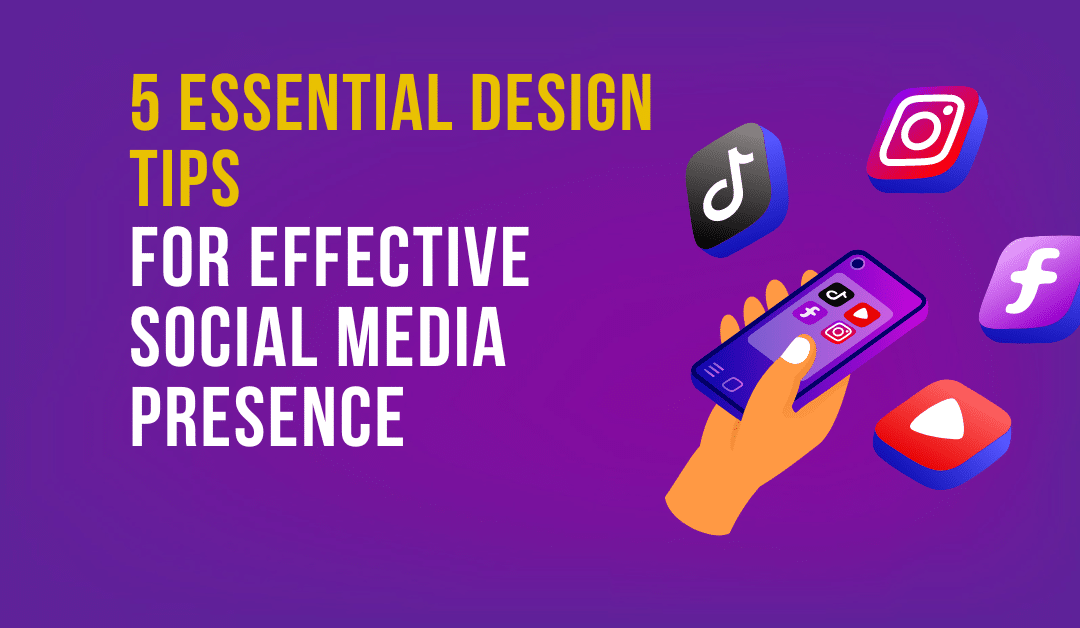The digital age has redefined the way we communicate, consume information, and do business. More than ever, social media has become a fundamental tool for businesses to connect with their audience, build brand awareness, and drive growth. As this digital landscape continues to evolve, one aspect remains consistently crucial: design. An effective social media presence is no longer just about posting regular content; it’s also about presenting it in a visually appealing and engaging way. That’s where social media design comes into play.
In this article, ‘5 Essential Design Tips for Effective Social Media Presence’, we’ll delve into the world of social media design and uncover how it can transform your online presence. Whether you’re a small business owner, a marketing professional, or just an individual aiming to enhance your social media game, this guide is for you. We’ll provide expert insights, practical tips, and examples to help you create social media content that not only catches the eye but also resonates with your audience and reinforces your brand identity.
So, are you ready to make your social media channels stand out among the crowd? Let’s get started!

Understanding Social Media Design
Unleashing the power of social media for your business starts with understanding the pivotal role of design. Without an eye-catching and consistent visual presence, your content can easily get lost in the fast-paced, crowded world of social media feeds.
Definition and Importance of Social Media Design
Social media design is the art of crafting compelling visual content for platforms like Facebook, Instagram, Twitter, and LinkedIn. It’s not just about creating pretty pictures; it’s about creating visuals that reinforce your brand’s identity, catch the viewer’s eye, and elicit an emotional response.
Beyond just individual posts, social media design encompasses everything from profile pictures to story graphics, to the overall aesthetic of your page. A well-thought-out social media design can bolster brand recognition, amplify your message, and make your posts stand out in a crowded feed.
Consider a travel brand like KAYAK, which uses a mix of high-quality photos and bold graphics to create visually appealing posts. This kind of consistent visual strategy helps to enhance brand recognition and capture the attention of potential followers.
Role of Social Media Design in Marketing
Social media design is a critical component of your overall marketing strategy. It’s not just about making your social media profiles look good; it’s about communicating your brand message, engaging your audience, and driving action.
Here’s why social media design is a game-changer in marketing:
- Brand Recognition: Consistent design elements like colors, fonts, and graphics make your brand easily identifiable across all social platforms.
- Engagement: Eye-catching visuals can increase engagement rates, encouraging likes, comments, and shares.
- Message Amplification: A well-crafted design can make your marketing message more memorable and shareable, extending your reach beyond your immediate audience.
In a nutshell, effective social media design can be a catalyst for building brand awareness, engaging your audience, and ultimately driving business results. But nailing the perfect design isn’t easy, especially when you have to cater to the unique specifications and user behaviors of different social platforms. That’s where professional design services like epIQ Creative Group can come in handy, providing top-notch design services to help you execute your marketing strategies with confidence.
In the following sections, we’ll be delving into some essential design tips that can help you create an effective and memorable social media presence.

Essential Design Tip 1: Building a Clear Visual Strategy
Creating a strong social media presence doesn’t happen by chance. It’s a result of building a clear visual strategy that aligns with your brand’s identity and resonates with your audience.
Importance of a Consistent Visual Identity
A consistent visual identity helps create brand recognition and makes your brand memorable. The more consistent your social media design is, the more likely your audience is to recognize your content instantly, even without seeing your brand name.
Think of your visual identity as your brand’s clothing. Whether it’s your logo, color scheme, typography or imagery, every element should consistently represent your brand’s personality and values. This consistency reinforces your brand’s identity, making it easier for your followers to understand what your brand stands for and why they should engage with you.
How to Develop a Visual Strategy for Social Media
Building a visual strategy for social media involves several steps.
1. Understand Your Audience: Start by understanding who your audience is and what type of visual content they prefer. This could involve conducting audience research, analyzing your existing engagement metrics, or even directly asking your followers through polls or surveys.
2. Create a Mood Board: A mood board is a collection of images, colors, fonts, and other design elements that inspire you and represent your brand’s style. It can serve as a visual guide for your social media design, helping ensure consistency.
3. Develop Themes: Themes can add variety to your content while maintaining a cohesive look and feel. For instance, you might have a theme for user-generated content, product showcases, or behind-the-scenes posts.
4. Choose Your Colors and Fonts: Your chosen colors and fonts should be consistent with your overall brand identity. They should be easy to read and pleasing to the eye.
5. Adapt for Each Platform: Different social media platforms have different user behaviors and preferences. What works on Instagram might not work on LinkedIn. Make sure your visual strategy considers the unique characteristics of each platform.
6. Plan Your Timing: Timing is crucial in social media. Make sure to post visuals at peak times when your audience is most active. Also, consider the bigger picture – plan your visual content around important dates or events relevant to your brand or industry.
In conclusion, a clear visual strategy is key to establishing a strong social media presence. It ensures consistency, reinforces your brand identity, and helps your content stand out in the crowded social media landscape. Remember, successful social media design is not just about making things look pretty – it’s about communicating your brand story in a way that resonates with your audience. And with a company like epIQ Creative Group on your side, creating a compelling visual strategy becomes a whole lot easier.
Essential Design Tip 2: Mastering the Basics of Design
Creating a visually appealing social media presence is not about crafting random pretty images but about mastering the fundamental rules of design. These rules are universal and apply to everything from print ads to social media posts. Let’s dive into the key design principles you should incorporate into your social media design strategy.
Understanding Color Psychology in Social Media Design
Color is one of the most powerful tools in a designer’s toolkit. It can provoke emotions, capture attention, and convey messages without words. In social media design, understanding color psychology can help you evoke the right emotions and set the tone for your content. For instance, blue is often associated with trust, red with excitement, and green with growth.
Choosing the right colors can also enhance your brand recognition. By consistently using a specific color palette that aligns with your brand, you can cultivate a distinctive and instantly recognizable visual identity. This is what “consistent branding” is all about, as mentioned in one of epIQ Creative Group’s articles.
The Role of Balance, Lines, and Typography in Design
Balance creates a sense of stability in your designs. It doesn’t always mean perfectly symmetrical layouts; sometimes, asymmetrical designs can also achieve balance through the clever use of color, scale, and position.
Lines, on the other hand, guide the viewer’s eye and create movement. They can be used to separate elements, frame content, or lead the eye to where you want it to go.
Typography is another key element that can make or break your design. Choosing the right font style, size, and spacing can drastically impact readability and the overall aesthetic of your posts. Consistency in typography is also important for brand recognition, so choose a set of fonts that reflect your brand’s personality and stick to them.
The Importance of Contrast, Scale, Proximity, Hierarchy, Repetition, Direction, and Space in Design
Contrast can be used to create visual interest and highlight important elements in your design. It can be achieved through variations in color, size, shape, and texture.
Scale and proximity are about the relationship between elements in your design. Scale can draw attention to specific elements, while proximity can group related elements together.
Hierarchy is all about prioritizing information by visually signaling the importance of elements. It guides your audience to your most crucial message first.
Repetition, as discussed in epIQ Creative Group’s article, helps establish and strengthen your brand elements.
Direction refers to the way the human eye moves across your designs. Understanding the common reading patterns like the “F,” “E,” and “Z” can help you place important elements strategically.
Finally, space, often referred to as negative or white space, surrounds other objects in the image. It adds a certain aesthetic quality to your design and highlights the most important elements.
Mastering these basic design principles will not only make your social media posts more visually appealing but also help you communicate more effectively with your audience.

Essential Design Tip 3: Utilizing Free Tools and Resources
In the world of social media design, you don’t need to be a Photoshop master or own a state-of-the-art design studio to create engaging visuals. There are numerous free tools and resources available that can equip you with the ability to design like a pro, even if you’re just starting.
Overview of Free Design Tools like Canva, Easelly, Adobe Express, and Pixlr
Let’s start with Canva, a graphic design platform that allows users to create social media graphics, presentations, posters, and other visual content. It provides access to a wide variety of templates and design types, enabling you to create engaging social media posts even without any design background.
Next up is Easelly, a free design tool that lets you create eye-catching infographics in minutes. You can choose from a host of ready-made templates or customize your own designs. It’s a great tool for transforming complex data into visually engaging content for your social media platforms.
Adobe Express is another fantastic tool for creating social media designs. It offers a simple drag-and-drop editor and over 34,000 templates that you can customize to match your brand’s aesthetic. With Adobe Express, you can create not only high-quality graphics but also video content, making it a versatile tool for your social media needs.
Lastly, for those who are more comfortable with photo editing, Pixlr is an excellent choice. This tool doubles as a photo editor and design tool, offering features like collages, photo filters, and layers. It also provides various pre-made templates and effects that can make designing for social media quick and easy.
How to Maximize the Use of These Tools for Social Media Design
While having access to these tools is fantastic, knowing how to maximize their use can truly set your social media designs apart.
Firstly, make sure to choose the right tool for the right job. For example, if you need to design an infographic, Easelly might be your best option. On the other hand, if you need to create a visually appealing Instagram story, Canva or Adobe Express may be more suitable.
Secondly, make use of the templates provided. These templates are created by professional designers and are a great starting point for your designs. You can customize them to suit your brand’s aesthetic and message.
Thirdly, don’t be afraid to experiment. Play around with different templates, colors, fonts, and images until you find what works best for your brand. Remember, the goal is to create designs that not only look good, but also resonate with your audience.
Lastly, keep your designs consistent. Consistency is key in building a recognizable brand on social media. Use similar fonts, colors, and styles across all your designs to create a cohesive visual identity.
By utilizing these free tools and resources, you can create stunning and effective social media designs without breaking the bank. Now, go forth and design!
Essential Design Tip 4: Prioritizing Accessibility and Representation
In the digital age, your social media presence is more than just a platform for marketing—it’s a representation of your brand’s values. A key part of this is making sure your social media design is inclusive and accessible to everyone.
Let’s dive into how we can achieve this.
The Importance of Inclusive Design in Social Media
Inclusive design means creating content that can be accessed, understood, and appreciated by all, regardless of their abilities or backgrounds. It’s about more than just ticking a box for corporate responsibility—it’s a strategic move that can help you reach a wider audience and foster brand loyalty.
Why is this important? Consider this: around 15% of the world’s population lives with some form of disability. That’s a significant portion of your potential audience that may struggle to interact with your content if it’s not designed with accessibility in mind.
Similarly, representation matters. Your audience is diverse, and they want to see themselves reflected in the content you create. By showcasing a wide range of people in your designs—across race, gender, age, body type, and more—you’re sending a powerful message that your brand is for everyone.
How to Ensure Your Social Media Design is Accessible and Represents Your Audience
So how can you make your social media design more accessible and representative? Here are some practical steps to get you started:
1. Use Alt-Text Descriptions: Alt-text allows the visually impaired to appreciate your images. Most social media platforms now provide fields for alt-text image descriptions.
2. Include Subtitles: All social videos should include captions. They’re crucial for hearing-impaired viewers and also help in sound-off environments.
3. Opt for High Contrast Colors: Be mindful of color choices. Avoid green and red or blue and yellow color combos as they’re more difficult to read for those with color blindness.
4. Diversify Your Imagery: Use inclusive stock photo libraries to ensure your visuals reflect the diversity of your audience. The 67% Collection and the Disrupt Aging Collection are excellent starting points.
5. Be Mindful of Representation: Avoid reinforcing gender or racial stereotypes with your visuals. Promote body positivity and diversity in all your designs.
By prioritizing accessibility and representation in your social media design, you’re not just creating a more inclusive online space—you’re leveraging the power of design to make a positive impact. Your audience will appreciate your efforts and reward you with their loyalty. After all, everyone wants to feel seen, heard, and valued.
Essential Design Tip 5: Optimizing Social Media Design for SEO
In the digital age, every pixel matters. Every image, every caption, and every hashtag can play a vital role in your brand’s online visibility. That’s where search engine optimization, or SEO, comes in. SEO isn’t just about optimizing your website—it’s also about optimizing your social media design.
The Connection Between Social Media Design and SEO
You may be wondering, “how does social media design tie in with SEO?” Well, the answer lies in the power of keywords, tags, and descriptions. These elements help search engines understand what your content is about and where to rank it in search results.
But SEO for social media goes beyond just text. It also involves the design elements of your posts—your images, videos, infographics, and other visuals. For instance, using relevant and high-quality images can help increase user engagement, which in turn can boost your SEO ranking. Similarly, incorporating keywords into your image file names and alt text can help improve your visibility in image search results.
Practical Tips for SEO-Optimized Social Media Design
Now that you know the why, let’s get into the how. Here are some practical tips to optimize your social media design for SEO:
- Use Relevant Keywords: Incorporate relevant keywords into your social media captions, image file names, and alt text. This can help search engines understand your content and rank it accordingly. For example, if you’re a clothing store, you might use keywords like “fashion,” “style,” and “clothing” in your posts.
- Create High-Quality Visuals: High-quality visuals can increase user engagement, which can boost your SEO ranking. Use tools like Canva or Easelly to create eye-catching graphics that resonate with your audience.
- Add Descriptive Tags: Use tags and hashtags strategically to categorize your content and make it easier for users to find. Just remember to keep it relevant—irrelevant or excessive tagging can harm your SEO ranking.
- Optimize Your Images: Large image files can slow down page load times, which can harm your SEO ranking. Use image compression tools to reduce your file sizes without sacrificing quality. Also, remember to add alt text to your images to improve their visibility in image search results.
SEO-optimized social media design is a powerful tool for boosting your online visibility and attracting more users to your content. By implementing these practices, you’ll not only enhance your social media presence, but also improve your overall SEO strategy.
Remember, every pixel, every keyword, and every tag counts. So make each one matter! And if you need help crafting a visually compelling and SEO-friendly social media strategy, the team at epIQ Creative Group is here to help.
Leveraging Professional Services for Social Media Design
As your brand grows, the demand for engaging and professionally designed social media content also increases. It’s at this juncture that it may be beneficial to consider hiring a social media designer.
When to Consider Hiring a Social Media Designer
The value of a strong social media presence cannot be overstated in today’s digital age. As such, it’s crucial to maintain a consistent and visually appealing brand image across all your social media platforms. This can be a daunting task, especially when juggling other business responsibilities.
So, when should you consider hiring a social media designer? If you’re finding it challenging to consistently produce engaging content, if your posts aren’t getting the attention they deserve, or if you simply don’t have the time or expertise to give your social media design the attention it needs, it might be time to bring in the professionals.
How epIQ Creative Group Can Help Enhance Your Social Media Presence
Enlisting the help of a professional design service like epIQ Creative Group can take your social media presence to the next level. With over a decade of experience, the team at epIQ specializes in creating visually stunning and engaging content that drives brand recognition and customer engagement.
From creating attention-grabbing graphics for posts and designing page layouts to producing video content and developing a cohesive brand style guide, epIQ has got you covered. Their team of experienced designers and marketers can help optimize your posts for maximum engagement, resulting in increased online visibility and customer loyalty.
Moreover, epIQ’s services are flexible and cost-effective. They offer month-to-month contracts and a-la-carte services, providing the expertise of a dedicated marketing team at a fraction of the cost of hiring in-house.
In short, with epIQ Creative Group, you can rest easy knowing your social media design needs are in good hands. They’re not just another digital marketing agency – they’re a partner committed to your success, guaranteeing not just growth, but unparalleled success for your business.
So, why wait? Elevate your social media presence with professional design services and watch your brand thrive like never before.
Conclusion
Recap of the 5 Essential Design Tips
And there you have it! A comprehensive guide to mastering your social media design strategy. Let’s revisit the crucial points:
- Building a Clear Visual Strategy: Crafting a consistent visual identity is paramount. It sets the tone for your brand, creates recognition, and shapes the narrative of your brand story.
- Mastering the Basics of Design: From color psychology to understanding design principles like balance, lines, typography, and space, mastering the basics gives your design a solid foundation.
- Utilizing Free Tools and Resources: Even without a background in design, tools like Canva, Easelly, Adobe Express, and Pixlr make creating engaging social media graphics a breeze.
- Prioritizing Accessibility and Representation: Inclusive design practices ensure your social media designs are accessible to all, fostering a sense of belonging among your audience.
- Optimizing Social Media Design for SEO: Social media and SEO are two sides of the same coin. By optimizing your social media design for SEO, you increase your chances of being found by your target audience.
Final Thoughts on Effective Social Media Presence Through Design
The importance of a well-designed social media presence cannot be overstated. It’s more than just aesthetics; it’s about creating a memorable brand identity, engaging with your audience, and maximizing your online visibility. It’s about telling your brand’s story in a way that resonates with your audience and builds trust.
But remember, while these tips provide a strong starting point, the beauty of social media design lies in its versatility and endless possibilities for creativity. Don’t be afraid to experiment and find what works best for your brand. And when in doubt, professional services like those offered by epIQ Creative Group can help you navigate the complexities of social media design.
In the end, an effective social media presence is not just about being seen — it’s about being remembered. And with the right design strategy, you can leave a lasting impression that keeps your audience coming back for more.

